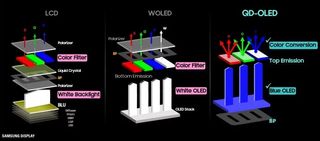As stunning as OLED display tech is, it has plenty of problems. Limited full-screen brightness and panel degradation known as burn in are probably the two most obvious. Even the very latest and greatest OLED monitors, such as the LG UltraGear 32GS95UE are not immune. But perhaps not for much longer.
When you dig down into the details, OLED’s shortcomings can often be traced directly or indirectly to limitations involving blue OLED subpixel technology. The problem with blue OLED tech is that it’s much less efficient than red and green, the other two primary subpixel colors.
That means that at a given power, blue OLED produces less light than red or green. Conversely, it uses much more power and produces much more heat at comparable brightness. Fix the blue OLED problem and you fix OLED tech more generally.
Well, that’s what LG claims to have done with its new “Dream OLED” panel technology (via ET News). The innovation involves a new panel utilising so-called blue phosphorescence.
Previously, blue OLED technology was restricted to less efficient fluorescent emission tech, while red and green OLED could be manufactured with more efficient phosphorescence emission.
In fact, the new LG panel reportedly uses a dual-stacked technique with both phosphorescence and fluorescent blue OLED in an effort to achieve both better efficiency and longevity.

Of course, the detailed implementation of such a technology is complicated. Neither LG nor Samsung, the two main players in OLED panel tech, actually implement a pure OLED RGB substructure. LG’s WOLED panels have an all-white OLED emission layer that is then passed through RGB filters, while Samsung actually has all-blue OLED emission which then excites an RGB quantum dot layer.
When you drill down even further into those OLED emission layers, you’ll find they have a further substructure, which is where the blue OLED solution will pay dividends. Anyway, blue OLED tech has long presented a barrier to creating OLED panels that can offer both strong full-screen brightness and good longevity with resistance to burn in.
This new Dream OLED panel tech from LG is said to be under production evaluation and could be commericialized “within the year”. Of course, that just means LG could begin manufacturing the panels for sale within a year. Actual PC monitors or TVs with the new panels would take a little longer.
But the take home here is LG seems to be addressing the big questions concerning OLED technology, namely how to match LCD for full screen brightness while also putting burn-in worries to bed.
It’s unclear exactly how far LG’s Dream OLED panels will go in delivering all that. But it certainly seems like they will be another step in that direction.
